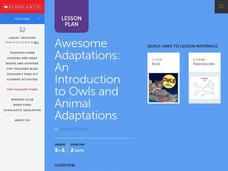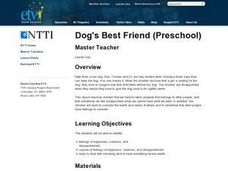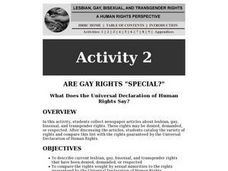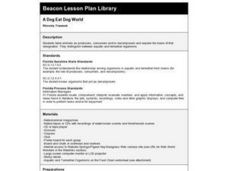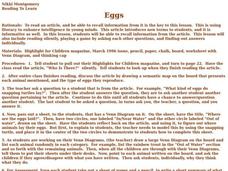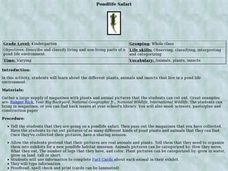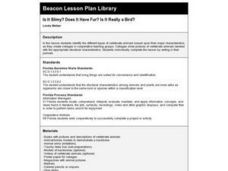Scholastic
Awesome Adaptations
Engaged learners discover how an owl beak works and how animals adapt to their environment. This task is part one of a three-part series.
Media Smarts
Looking at Food Advertising
Tony The Tiger, The HoneyComb Kid, The Nestle Quick Bunny. As part of a study of the methods advertisers use to sell foods and how this advertising effects their food choices, kids create their own spokescharacter and/or jingle for...
Curated OER
Dog's Best Friend
Students learn about and identify feelings of happiness, sadness and disappointment. In this feelings lesson, students have a show and tell time about their pets and discuss how it would feel if they lost their pet. Students watch a...
Curated OER
Ocean Commotion Activity - Dioramas
Groups make a model of an Ocean Commotion exhibit based on what they saw during the fieldtrip. These dioramas can be used as an informal assessment of student knowledge acquired at Ocean Commotion.
Curated OER
Are Gay Rights "Special"?
Inspire critical thinking with this activity, which prompts students to compare lesbian, gat, bisexual, and transgender rights with the rights guaranteed by the Universal Declaration of Human Rights. By collecting topical articles about...
Curated OER
Living-Nonliving
Students determine that environments have living and nonliving parts. They discuss what makes something a living thing and something a nonliving thing. They make a chart and list characteristics of living things and nonliving things.
Discovery Education
Make it all Better!
Discover how innovations can help your school and community. In the three-part STEM lesson, scholars learn the meaning of innovation and brainstorm innovations in their schools. They identify issues in their communities and think of...
Curated OER
A Dog Eat Dog World
Fourth graders distinguish between acquatic and terrestrial organisms. They label animals as producers, consumers, and/or decomposers.
Curated OER
Up the Down Tree House
Students investigate the decomposition process. In this ecology activity, students participate in a play, "Up the Treehouse" where the main idea focuses on a decomposing tree and how food chains are effected by decomposition. After the...
Curated OER
Eggs
Help your young scholars practice reading an article to improve their literary skills with new terms and summarizing information. They read silently and then play a game by asking each other questions and finding out answers...
Curated OER
Visit To the Farm
Young scholars research farm animals and write a story based on the research.
Curated OER
Red Wigglers
Students are introduced to the benefits of using Red Wiggler worms to produce compost. They identify the requirements for the worms and the methods to follow in order to produce compost. They draw a picture of a functioning worm bin.
Curated OER
Manga and Me
Upper elementary and middle school learners study Manga cartooning and create a Japanese character based on their own features and personalities. This style of cartooning is easily-accessible for most young scholars. With a little...
Curated OER
Farms And Cities
Students differentiate the differences of living on a farm or in a city. They do this with the use of coloring pictures and have group discussion about each picture to identify characteristics and identify where the picture is from. The...
Curated OER
Pond-life Safari
Students determine the living and non-living parts of pond life. In this pond life lesson, students examine the plants, animals, and insects that live in ponds. They look through a variety of print media, cut out pictures, and arrange...
Curated OER
Food Webs
Students produce a newspaper covering topics related to food webs. They use print and electronic sources to gather information about specific animals. They share their information with the class.
Curated OER
Vertebrate Dioramas
Students are able to describe the development of their chosen form of vertebrate life from the past to the present in a four to six page typed paper. They explain the use of phylogenetic tree. Students use the phylogenetic tree to...
Curated OER
Vertebrate Dioramas
Students describe the development of their chosen form of vertebrate life from the past to the present in a four to six page paper. They explain the use of a phylogenetic tree, and use this to exemplify an organism's evolutionary change...
Curated OER
Magnificent Mammals
Students experience center activities to study the habitats and traits of mammals. They play a memory game, eat like mammals, produce artwork and read mammal books.
Curated OER
The Lion and the Mouse
Students write a story. In this critical thinking and writing lesson, students read a fable, answer the provided thinking skills questions, and write their own fable.
Curated OER
Unearthing the Past
Students analyze artifacts from an early society to determine information relating to daily life in that society. They consider which artifacts from our society would be most valuable to future archeologists.
Curated OER
Is It Slimy? Does It Have Fur? Is It Really a Bird?
Sixth graders identify the different types of vertebrate animals based upon their major characteristics, as they create collages in groups. Collages show pictures of vertebrate animals labeled with the appropriate structural...
Curated OER
What Teeth Tell Us
Students view pictures of a variety of animals. They examine the animals' teeth and discuss the differences in them. They experiment with staple removers (carnivore teeth) and two flat rocks (herbivore teeth) and determine which are most...
Curated OER
Chow
In this reading comprehension worksheet, students read a four paragraph story. After reading, students answer five multiple choice, three short answer, and six fill in the blank questions about the story. They also write a paragraph and...
